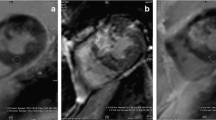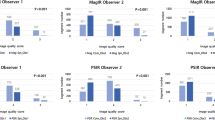Abstract
To develop a quantitative T1-mapping-based synthetic inversion recovery (IRsynth) approach to calculate the optimal inversion time (TI0) for late gadolinium enhancement (LGE) imaging. Prospectively enrolled patients (n = 130, 58 ± 16 years) underwent cardiac MRI on a 1.5T system including Look-Locker TI-scout (LL), modified LL IR (MOLLI)-based T1-mapping, and LGE acquisitions. Patients were randomized into two groups: LL group (TI-scout followed T1-mapping) or MOLLI group (T1-mapping followed TI-scout). In both groups, the second acquisition was used to determine the TI0 for LGE. IRsynth images were generated from T1-maps between TI = 200–400 ms in 5 ms increments. Image quality was rated on a 3-point scale and the remote/background signal intensity ratio (SIR) was calculated. In the LL group (n = 53), the TI-scout-based TI0 was significantly shorter compared to IRsynth [230 ms (219–242) vs. 280 ms (263–297), P < 0.0001]. The TI0 used for LGE was set 30–40 ms longer [261 ms (247–276), P < 0.0001] than the TI-scout-based TI0, resulting in a TI0 ~ 20 ms shorter than what was obtained by IRsynth (P = 0.0156). In the MOLLI group (n = 63), IRsynth-based TI0 was significantly longer than the TI-scout-based TI0 [298 ms (262–334) vs. 242 ms (217–267), P = 0.0313]. The quality of myocardial nulling was rated higher [2.4 (2.2–2.5) vs. 2.0 (1.8–2.1), P = 0.0042] and the remote/background SIR was found to be more optimal (1.6 [1.1–2.1] vs. 2.6 [1.8–3.3], P = 0.0256) in the MOLLI group. T1-based IRsynth selects TI0 for LGE more accurately than conventional TI-scout imaging. IRsynth improves TI0 selection by providing excellent visualization of the representative image contrast for LGE images, reducing operator dependence in LGE acquisition.



Similar content being viewed by others
References
American College of Radiology, Society of Cardiovascular Computed Tomography, Society for Cardiovascular Magnetic Resonance, American Society of Nuclear Cardiology, North American Society for Cardiac Imaging, Society for Cardiovascular Angiography, Interventions, Society of Interventional Radiology (2006) ACCF/ACR/SCCT/SCMR/ASNC/NASCI/SCAI/SIR 2006 appropriateness criteria for cardiac computed tomography and cardiac magnetic resonance imaging. A report of the American College of Cardiology Foundation Quality Strategic Directions Committee Appropriateness Criteria Working Group. J Am Coll Radiol 3:751–771
Kellman P, Arai AE, McVeigh ER, Aletras AH (2002) Phase-sensitive inversion recovery for detecting myocardial infarction using gadolinium-delayed hyperenhancement. Magn Reson Med 47:372–383
Kim RJ, Shah DJ, Judd RM (2003) How we perform delayed enhancement imaging. J Cardiovasc Magn Reson 5:505–514
Simonetti OP, Kim RJ, Fieno DS, Hillenbrand HB, Wu E, Bundy JM, Finn JP, Judd RM (2001) An improved MR imaging technique for the visualization of myocardial infarction. Radiology 218:215–223
Look DC, Locker DR (1970) Time saving in measurement of NMR and EPR relaxation times. Rev Sci Instrum 41:250–251
Messroghli DR, Radjenovic A, Kozerke S, Higgins DM, Sivananthan MU, Ridgway JP (2004) Modified Look-Locker inversion recovery (MOLLI) for high-resolution T1 mapping of the heart. Magn Reson Med 52:141–146
Varga-Szemes A, van der Geest RJ, Schoepf UJ, Spottiswoode BS, De Cecco CN, Muscogiuri G, Wichmann JL, Mangold S, Fuller SR, Maurovich-Horvat P, Merkely B, Litwin SE, Vliegenthart R, Suranyi P (2017) Effect of inversion time on the precision of myocardial late gadolinium enhancement quantification evaluated with synthetic inversion recovery MR imaging. Eur Radiol 27:3235–3243
Varga-Szemes A, van der Geest RJ, Spottiswoode BS, Suranyi P, Ruzsics B, De Cecco CN, Muscogiuri G, Cannao PM, Fox MA, Wichmann JL, Vliegenthart R, Schoepf UJ (2016) Myocardial late gadolinium enhancement: accuracy of T1 mapping-based synthetic inversion-recovery imaging. Radiology 278:374–382
Xue H, Shah S, Greiser A, Guetter C, Littmann A, Jolly MP, Arai AE, Zuehlsdorff S, Guehring J, Kellman P (2012) Motion correction for myocardial T1 mapping using image registration with synthetic image estimation. Magn Reson Med 67:1644–1655
Kellman P, Hansen MS (2014) T1-mapping in the heart: accuracy and precision. J Cardiovasc Magn Reson 16:2
Schlosser T, Hunold P, Herborn CU, Lehmkuhl H, Lind A, Massing S, Barkhausen J (2005) Myocardial infarct: depiction with contrast-enhanced MR imaging–comparison of gadopentetate and gadobenate. Radiology 236:1041–1046
Muscogiuri G, Rehwald WG, Schoepf UJ, Suranyi P, Litwin SE, De Cecco CN, Wichmann JL, Mangold S, Caruso D, Fuller SR, Bayer Nd RR, Varga-Szemes A (2017) T(Rho) and magnetization transfer and INvErsion recovery (TRAMINER)-prepared imaging: a novel contrast-enhanced flow-independent dark-blood technique for the evaluation of myocardial late gadolinium enhancement in patients with myocardial infarction. J Magn Reson Imaging 45:1429–1437
Dietrich O, Raya JG, Reeder SB, Reiser MF, Schoenberg SO (2007) Measurement of signal-to-noise ratios in MR images: influence of multichannel coils, parallel imaging, and reconstruction filters. J Magn Reson Imaging 26:375–385
Kellman P, Herzka DA, Hansen MS (2014) Adiabatic inversion pulses for myocardial T1 mapping. Magn Reson Med 71:1428–1434
Petersen SE, Mohrs OK, Horstick G, Oberholzer K, Abegunewardene N, Ruetzel K, Selvanayagam JB, Robson MD, Neubauer S, Thelen M, Meyer J, Kreitner KF (2004) Influence of contrast agent dose and image acquisition timing on the quantitative determination of nonviable myocardial tissue using delayed contrast-enhanced magnetic resonance imaging. J Cardiovasc Magn Reson 6:541–548
Wagner A, Mahrholdt H, Thomson L, Hager S, Meinhardt G, Rehwald W, Parker M, Shah D, Sechtem U, Kim RJ, Judd RM (2006) Effects of time, dose, and inversion time for acute myocardial infarct size measurements based on magnetic resonance imaging-delayed contrast enhancement. J Am Coll Cardiol 47:2027–2033
Ferreira VM, Liu A, Marini C, Davis A, Francis JM, Neubauer S, Piechnik SK (2016) Post-contrast T1-mapping provides a novel approach to optimal myocardial nulling for late gadolinium enhancement imaging: a quantitative prescription for the correct TI without the guesswork. J Cardiov Magn Reson 18:P22
Nacif MS, Turkbey EB, Gai N, Nazarian S, van der Geest RJ, Noureldin RA, Sibley CT, Ugander M, Liu S, Arai AE, Lima JA, Bluemke DA (2011) Myocardial T1 mapping with MRI: comparison of look-locker and MOLLI sequences. J Magn Reson Imaging 34:1367–1373
Kecskemeti S, Johnson K, Francois CJ, Schiebler ML, Unal O (2013) Volumetric late gadolinium-enhanced myocardial imaging with retrospective inversion time selection. J Magn Reson Imaging 38:1276–1282
Messroghli DR, Greiser A, Frohlich M, Dietz R, Schulz-Menger J (2007) Optimization and validation of a fully-integrated pulse sequence for modified look-locker inversion-recovery (MOLLI) T1 mapping of the heart. J Magn Reson Imaging 26:1081–1086
Piechnik SK, Ferreira VM, Dall’Armellina E, Cochlin LE, Greiser A, Neubauer S, Robson MD (2010) Shortened modified Look-Locker inversion recovery (ShMOLLI) for clinical myocardial T1-mapping at 1.5 and 3 T within a 9 heartbeat breathhold. J Cardiovasc Magn Reson 12:69
Abdula G, Sorensson P, Lundin M, Svedin J, Klein M, Kellman P, Sigfridsson A, Ugander M (2014) Synthetic phase sensitive inversion recovery late gadolinium enhancement from post-contrast T1-mapping shows excellent agreement with conventional PSIR-LGE for diagnosing myocardial scar. J Cardiovasc Magn Reson 16:P213
Hong K, DiBella EV, Kholmovski EG, Ranjan R, McGann CJ, Kim D (2014) Synthetic LGE derived from cardiac T1 mapping for simultaneous assessment of focal and diffuse cardiac fibrosis. J Cardiovasc Magn Reson 16:P362
Author information
Authors and Affiliations
Corresponding author
Ethics declarations
Conflict of interest
UJS is a consultant for and/or receives research support from Astellas, Bayer, GE Healthcare, and Siemens. CNDC and AVS are consultants for and/or receive research support from Guerbet and Siemens. WGR is an employee of Siemens. The other authors have no conflict of interest and had control of the data submitted for publication.
Ethical approval
All procedures performed in studies involving human participants were in accordance with the ethical standards of the local Institutional Review Board and with the Health Insurance Portability and Accountability Act.
Informed consent
Informed consent was obtained from all individual participants included in the study.
Rights and permissions
About this article
Cite this article
Gassenmaier, S., van der Geest, R.J., Schoepf, U.J. et al. Quantitative inversion time prescription for myocardial late gadolinium enhancement using T1-mapping-based synthetic inversion recovery imaging: reducing subjectivity in the estimation of inversion time. Int J Cardiovasc Imaging 34, 921–929 (2018). https://doi.org/10.1007/s10554-017-1294-9
Received:
Accepted:
Published:
Issue Date:
DOI: https://doi.org/10.1007/s10554-017-1294-9




